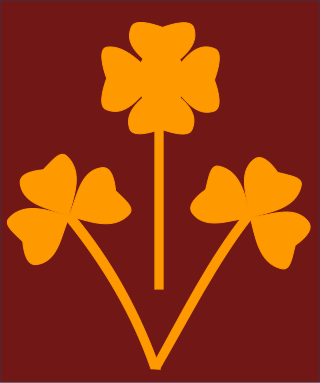
The 4th Indian Infantry Division, also known as the Red Eagle Division, is an infantry division of the Indian Army. This division of the British Indian Army was formed in Egypt in 1939 during the Second World War. During the Second World War, it took part in campaigns in East Africa, Syria, North Africa and Italy. Post independence, the division is part of the I Corps and headquartered at Prayagraj.

Fort Moore is a United States Army post in the Columbus, Georgia area. Located on Georgia's border with Alabama, Fort Moore supports more than 120,000 active-duty military, family members, reserve component soldiers, retirees and civilian employees on a daily basis. As a power projection platform, the post can deploy combat-ready forces by air, rail, and highway for their designated mission. Fort Moore is the home of the United States Army Maneuver Center of Excellence, the United States Army Armor School, United States Army Infantry School, the Western Hemisphere Institute for Security Cooperation, elements of the 75th Ranger Regiment, the 1st Security Force Assistance Brigade, and other tenant units.

The Northumberland County Division was a formation of the British Army in the Second World War, its headquarters were formed on 24 February 1941. It ceased to function on 1 December 1941, and the headquarters were disbanded on 21 December 1941. It was commanded by Major-General R. C. Money and was an infantry only formation consisting of three Independent Infantry Brigades (Home). Combat support, artillery, engineers etc., would be provided by other local formations. It was commanded by X Corps until 9 April, IX Corps until 30 November and War Office control from then until disbandment.

The 5th Indian Infantry Division was an infantry division of the Indian Army during World War II that fought in several theatres of war and was nicknamed the "Ball of Fire". It was one of the few Allied divisions to fight against three different armies - the Italian, German and Japanese armies.

The 8th Mountain Division was raised as the 7th Indian Infantry division of the British Indian Army. It is now part of the Indian Army and specialises in mountain warfare.

The 23rd Infantry Brigade was an infantry brigade of the British Army that saw active service in the First World War, mainly on the Western Front During the Second World War, the brigade saw active service in the Syria-Lebanon Campaign, the Western Desert Campaign, and the Burma Campaign.
The 13th Infantry Brigade was a regular infantry brigade of the British Army that saw active service during both the First and the Second World Wars.

The 29th Infantry Brigade was an infantry brigade unit of the British Army. It was originally raised in 1914 and saw service during the First and Second World Wars and the Korean War.
The 11th Indian Infantry Brigade was an infantry brigade formation of the Indian Army during World War II. It was relocated from India to Egypt in the middle of August 1939 and trained at Fayed in Ismailia Governorate on the Great Bitter Lake. In October 1939, it was assigned to the 4th Indian Infantry Division. In May 1942, it was attached to the 5th Indian Infantry Division and in June the 2nd South African Infantry Division when it surrendered after Tobruk was captured by the Germans and Italians in 1942. The brigade was then reformed in Egypt in October 1943 and once more assigned to the 4th Indian Division serving in Tunisia, Italy and, at the end of the war, in Greece.
The 17th Indian Infantry Brigade was an infantry brigade formation of the Indian Army during World War II.
The 10th Indian Infantry Brigade was an infantry brigade formation of the Indian Army during World War II. It was formed in September 1939. In June 1940 it was assigned to the 5th Indian Infantry Division and in September 1940, sailed for East Africa. The brigade spent time attached to other formations, the 4th Indian Infantry Division between June 1940 and March 1941, and the British 10th Armoured Division between March and June 1942, where it was destroyed during the Battle of Gazala. A new brigade was formed in Egypt and assigned to the 10th Indian Infantry Division, with which it fought in the Italian Campaign from April 1944 until the end of the war.
The 213th Brigade was a Home Defence and training formation of the British Army during both the First and Second World Wars.
The 1st Motorised Brigade was a formation of the Royal Hungarian Army that participated in the Axis invasion of Yugoslavia during World War II.
The 2nd Motorised Brigade was a formation of the Royal Hungarian Army that participated in the Axis invasion of Yugoslavia during World War II.
The 10th Infantry Brigade was a formation of the Royal Hungarian Army that participated in the Axis invasion of Yugoslavia during World War II.
The 11th Infantry Brigade was a formation of the Royal Hungarian Army that participated in the Axis invasion of Yugoslavia during World War II.
The 12th Infantry Brigade was a formation of the Royal Hungarian Army that participated in the Axis invasion of Yugoslavia during World War II.
The 13th Infantry Brigade was a formation of the Royal Hungarian Army that participated in the Axis invasion of Yugoslavia during World War II.
The 15th Infantry Brigade was a formation of the Royal Hungarian Army that participated in the Axis invasion of Yugoslavia during World War II.
The 19th Infantry Brigade was a formation of the Royal Hungarian Army that participated in the Axis invasion of Yugoslavia during World War II.






